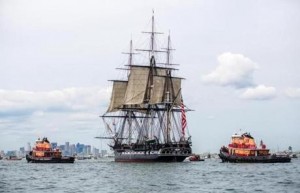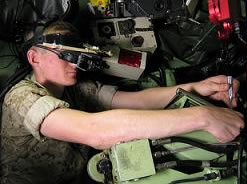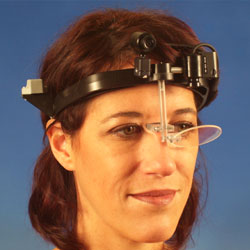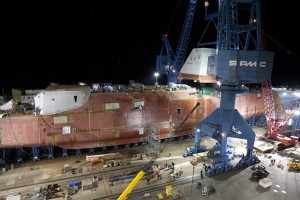January is named for the Roman God Janus, the two-faced deity of the doorway or the threshold. With one face looking toward the future, and the other contemplating the past, Janus inspires the annual reviews of naval affairs as well as the predictions for the future that we see in the naval blogosphere. New Years 2013 in the maritime world is no different than in years past.
Over at Information Dissemination our favorite China shipyard-watcher Feng has a great post summarizing where the People’s Liberation Army Navy has been in the past year. Two things caught our eye in reading through Feng’s summary. First, seeing it all laid out in one place really emphasizes the capacity that is being developed by Chinese shipyards. For all the discussion of a dwindling industrial base in the United States, it is interesting to watch the pace of work in the Chinese shipbuilding industry. Second, we shouldn’t miss the massive construction underway for the maritime policing and Coast Guard equivalents in the People’s Republic. USCG cutters routinely deploy globally, sailing with USN ships in the Arabian Gulf and Pacific as well as the regular patrol of our backyard in the Caribbean. As China continues to build cutters and grows the size of their maritime security forces, we should expect them to develop interoperability with the PLAN in the same way the USCG and USN have developed their concept of The National Fleet. This melding of law enforcement patrol with military operations (based on a model provided by the Americans) in the South and East China Seas will continue to complicate the issues there.
Also at ID, CDR Bryan McGrath gives us a quick look at some highlights for I&W to watch for in 2013. We were glad to see him place the Blue/Green Team as his top item to keep an eye on. The Marines need to get over their fears of another Guadalcanal and return to their historic roots as an integrated part of naval forces. The Navy needs to overcome their self-consciousness about their comparative lack of recent combat experience and learn to look to the Marines for ideas and help in developing new concepts. It is time that both forces genuinely came together as an integrated, hybrid force rather than a pair of brothers constantly arm wrestling over who side is “supported” and who is “supporting.” We also note that discussions about the future of the Air Wing are on CDR McGrath’s list. That’s easy for a former SWO to say, but he’s right. The Naval Aviators amongst us are going to have to realize that there need to be some serious changes. Hard thinking, innovative ideas, and practical experimentation and testing will be required…humming “Highway to the Danger Zone” and quoting Goose and Slider will only give our adversaries more time to realize our weaknesses and take advantage of them. Maverick told us that you don’t have time to think up there…unfortunately today’s challenges require us to have people who are practiced and capable thinkers.
Elsewhere online the sometimes genial, sometimes grumpy, CDR Salamander takes a broader view toward the future at his blog. Strategy is the matching of ends, ways, and means. Sal points out that the United States must figure out the last part, with an honest and genuine assessment of the national financial status. Without it, developing “the ends” of national policy, and “the ways” of a sound Naval policy and shipbuilding plan, is impossible. That honest assessment…it isn’t going to be pretty. It has some very serious ramifications for the Department of the Navy, but also for every single part of American society.
We encourage you to follow the links and read the posts. There is some serious thinking here, some deep analysis, and some quick ideas that can help us frame the coming year – all worth your time. Janus is the namesake of the first month of the year and serves as a symbol of our New Year’s passion for self-assessment. He also serves as a fantastic symbol for naval analysts in general as we attempt to clarify the lessons of the past to illuminate our way into the future. If you’re still feeling a need for speed though, check this out to get your 2013 off to the right start.
The Firm of Maynard, Cushing, & Ellis does not represent the opinions of anyone that matters. Formed by Lieutenant Robert Maynard RN, Lieutenant William Cushing USN, and Captain Pete Ellis USMC, the firm doesn’t speak for the US Government, the Department of Defense, The Foreign Office, the Department of Housing and Urban Development, or the Department of Silly Walks.







